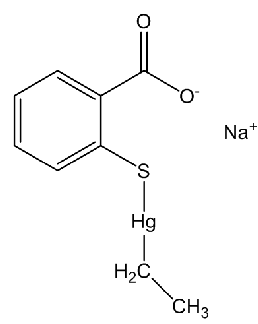![]()
Thiomersal
The molecule that prevents
vaccines from going stale.
![]()
Simon Cotton
University of Birmingham, UK
![]()
Molecule of the Month February 2015
Also available: JSmol version.
![]()

ThiomersalThe molecule that prevents
|
 |
Yes, it is a two-coordinate mercury complex. Though this coordination number is rare for transition metals, it is common for the d10 metal ions Hg2+, Au+ and to a lesser degree Ag+, Pd0 and Pt0.
Well, although the ethyl group doesn’t get a mention, most of the rest of the mercury-containing ion does. The mercury is bound to thiosalicylic acid, hence Thio-Mer-Sal. It also goes under the name given by the company (Eli Lilly) that developed and patented it, Merthiolate. It was one of the discoveries of the great American organic chemist Morris Selig Kharasch (1895 –1957).
Mercury compounds have long been used medicinally. Mercury chloride was for many years used to treat syphilis, though its harmful effects outweighed any benefits. Mercury oxide was for many years (at least until the 1970s) used in medications like Golden Eye Ointment. Thiomersal’s role has been as a vaccine preservative. It has been suggested that the CH3CH2Hg+ ion is the active species.
The standard method seems to be that employed by Kharasch, reaction between ethylmercury-chloride, aqueous sodium hydroxide and thiosalicylic acid.

Vaccination was invented by Edward Jenner, who in 1796 used cowpox to create immunity to smallpox. Pasteur came up with a rabies vaccine in 1885, and in the coming years vaccines were developed against more and more diseases, such as diphtheria, tetanus, anthrax, cholera and typhoid. Effective though they were (and have continued to be) a problem confronting practitioners of early 20th-century child immunisation was bacterial contamination of vaccines. In the most severe of a number of cases in 1928, 12 out of 21 children inoculated with contaminated diphtheria vaccine died of multiple staphylococcal abscesses and toxaemia in Queensland, Australia.
Whilst no preservative is needed for a single-dose vaccine, multi-dose samples usually have a rubber cap through which doses are withdrawn, and there is the possibility of bacterial contamination when a syringe needle is inserted.

Not as widely as once was the case.
During the 1990s, more and more parents of autistic children were concerned about the causes of their child’s complaint and the services and treatments available. It is not clear to what extent the increased prevalence of autism was one of perception or due to changes in diagnosis. At this time the use of mercury-containing compounds in medicine - not just thiomersal – came under scrutiny, and despite the lack of clear evidence linking it to autism, the precautionary principle was invoked and thiomersal was removed from vaccines in the USA by the end of 2001. Some US states have passed laws limiting use of thiomersal-containing vaccines, which presented problems at the time of the swine-flu outbreak in 2009-2010, as the multidose vaccines available contained thiomersal. Some parents have resorted to chelation therapy (such as EDTA) to remove mercury from the body, seeing autism as a type of mercury poisoning, leading to a 5-year old child dying following the use of EDTA.
It’s been pointed out that several factors converged at around that time. A now-discredited study reported that there was a link between the MMR (measles, mumps, and rubella) vaccine and autism, making vaccination suspect in the eyes of some; mercury compounds had come under scrutiny following events that began with the Minamata affair, running into the 1980s with studies of possible links between mercury levels and IQ; and increased levels of diagnosed autism, notably in the USA. Parents of children with autism were looking for a possible cause of these increased autism rates. It tended to be assumed in the public domain that an ethylmercury species would present similar problems of toxicity to the methylmercury compounds familiar from Minamata and related studies, whereas ethylmercury compounds are excreted much faster by the body, so not so likely to accumulate to harmful concentrations.
Over the past 15 years, many studies have examined the evidence, failing to find any link between the use of thiomersal and autism. Even though thiomersal was removed from vaccines in Sweden and Denmark and Sweden in 1992 – earlier than in the USA – autism rates continued to increase, as they did in California following its removal there. Blood mercury levels of patients vaccinated with thiomersal have been found to be below safe limits.

Another point is that autism seems to run in families, so that there are genetic factors contributing to the risk of developing autism. A Swedish study has reported that the individual risk of autistic problems increased with increasing genetic relatedness. Statements have been made by the World Health Organisation (WHO) including:
“Because of its excellent track record of safety and efficacy as a vaccine preservative over many years, WHO will continue to recommend vaccines containing thiomersal. On balance, the known risk of morbidity and mortality from vaccine-preventable diseases and the dangers posed by contaminated multidose vaccine vials far outweigh any potential risk posed by thiomersal.”
and
“Upon review of the current epidemiologic evidence and phamacokinetic profile of thiomersal, the Global Advisory Committee on Vaccine Safety concluded that there is currently no evidence of mercury toxicity in infants, children, or adults exposed to thiomersal in vaccines. It also concluded that there is no reason to change current immunization practices with thiomersal-containing vaccines on the grounds of safety.”
Other bodies have made similar statements.
![]()
![]() Back to Molecule of the Month page. [DOI:10.6084/m9.figshare.5259742]
Back to Molecule of the Month page. [DOI:10.6084/m9.figshare.5259742]